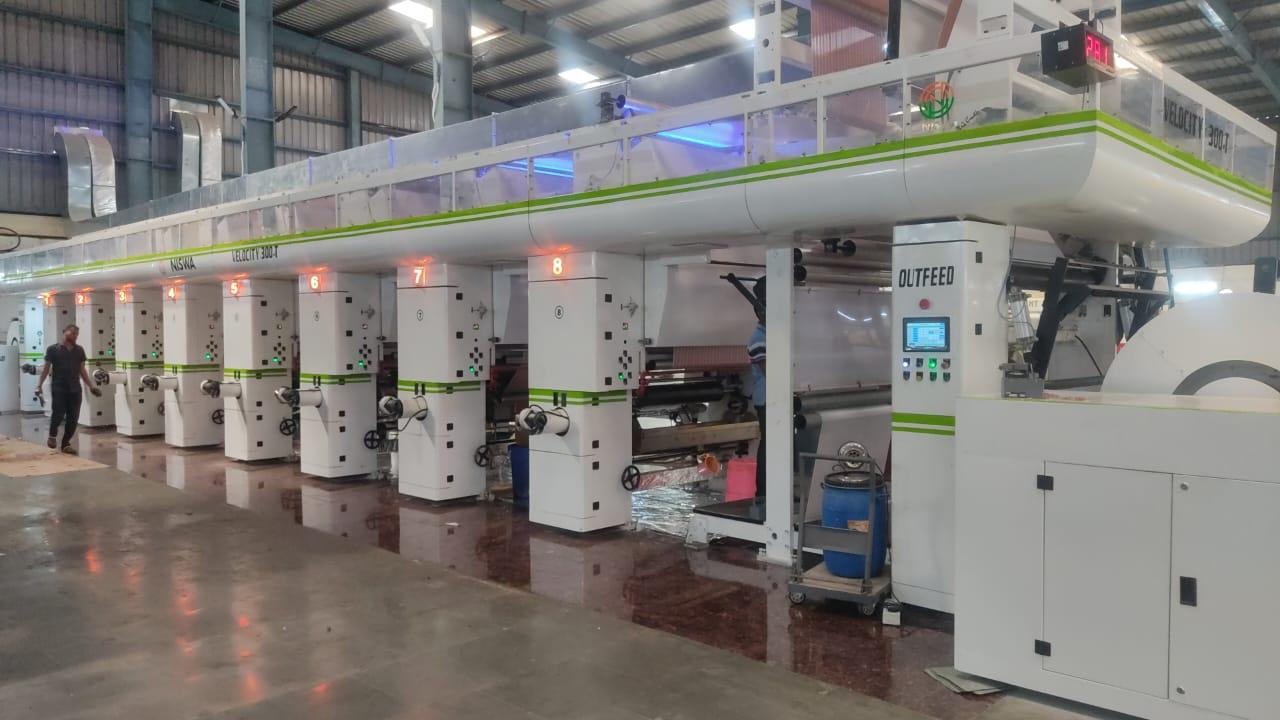Rotogravure Printing Machine
A rotogravure printing machine is a high-speed, high-quality printing press primarily used for long print runs and mass production of packaging materials, labels, newspapers, magazines, and other similar products. It employs the rotogravure printing process, which involves engraving an image onto a cylinder and transferring ink onto the printing substrate. Here’s a detailed overview of the machine and its features:

Rotogravure Printing Machine with Turret & Splicing 300MPM
| Rotogravure Printing Machine | Unit | MLS-T 300mpm |
| Mechanical Speed | Mpm | 300 |
| Max./Min Web Width | mm | 1320/1050 |
Print Repeat Range Max./Min | mm | 800/400 |
| Printing Cylinder width Max./Min | mm | 1370/1050 |
Maximum Roll Diameter (Unwinder) | mm | 800/1000 |
| Inside Core Diameter (Unwinder) | mm | 76/152 |
Maximum Roll Diameter (Rewinder) Inside Core Diameter (Rewinder) | 800/1000
152 |
| Rotogravure Printing Machine | Unit | MLS-T 250 |
| Speed | Mpm | 250 |
| Max./Min Web Width | mm | 1000/650 |
Print Repeat Range Max./Min | mm | 800/400 |
| Printing Cylinder width Max./Min | mm | 1070/720 |
Maximum Roll Diameter (Unwinder) | mm | 800/1000 |
| Inside Core Diameter (Unwinder) | mm | 76/152 |
Maximum Roll Diameter (Rewinder) Inside Core Diameter (Rewinder) | 800/1000
152 |

Description
1. Unwinder:
- This is where the printing material, often a continuous roll of paper or film, is loaded onto the machine.
2. Printing Cylinder:
- The heart of the rotogravure process. This cylinder has engraved cells or depressions that hold the ink. These cells are created using an engraving process that can be chemical or electronic. Each cylinder corresponds to a specific color in the final image.
3. Inking System:
- It supplies ink to the engraved cells on the printing cylinder. Doctor blades scrape excess ink off the cylinder's surface, leaving ink only in the engraved cells.
5. Impression Roller:
- This applies pressure to the printing material, ensuring proper ink transfer from the printing cylinder to the material.
4. Drying System:
- As the printing material passes through the machine, the ink needs to dry quickly. Dryers (often using heat or air) are positioned along the path to evaporate the solvents and set the ink.
6. Rewinder:
- At the end of the process, the printed material is wound onto a roll for further processing or packaging.
Material Handled
- Flexible Films: Polyethylene (PE), polypropylene (PP), polyester (PET), nylon, and other plastic films commonly used in flexible packaging.
Paper: Various grades of paper including coated, uncoated, kraft, and specialty papers used in packaging, labels, and publishing.
Foils: Thin metal foils such as aluminum and copper used in packaging, labels, and decorative applications.
Laminates: Multi-layered materials combining different substrates, such as paper-aluminum laminates or plastic-foil laminates used in flexible packaging.
Carton Board: Solid cardboard and paperboard used in folding cartons, labels, and other packaging applications.
Textiles: Fabric materials used for packaging, labels, and decorative applications.
Labels: Self-adhesive labels made from paper or synthetic materials used in product labeling and packaging.
Non-Woven Fabrics: Textile-like materials made from fibers bonded together, commonly used in hygiene products and medical packaging.
Flexible Packaging: Various types of pouches, bags, and wrappers made from flexible films and laminates for food, beverage, and consumer goods packaging.
Decorative Materials: Specialty materials like wallpaper, gift wrap, and decorative foils used for aesthetic purposes
